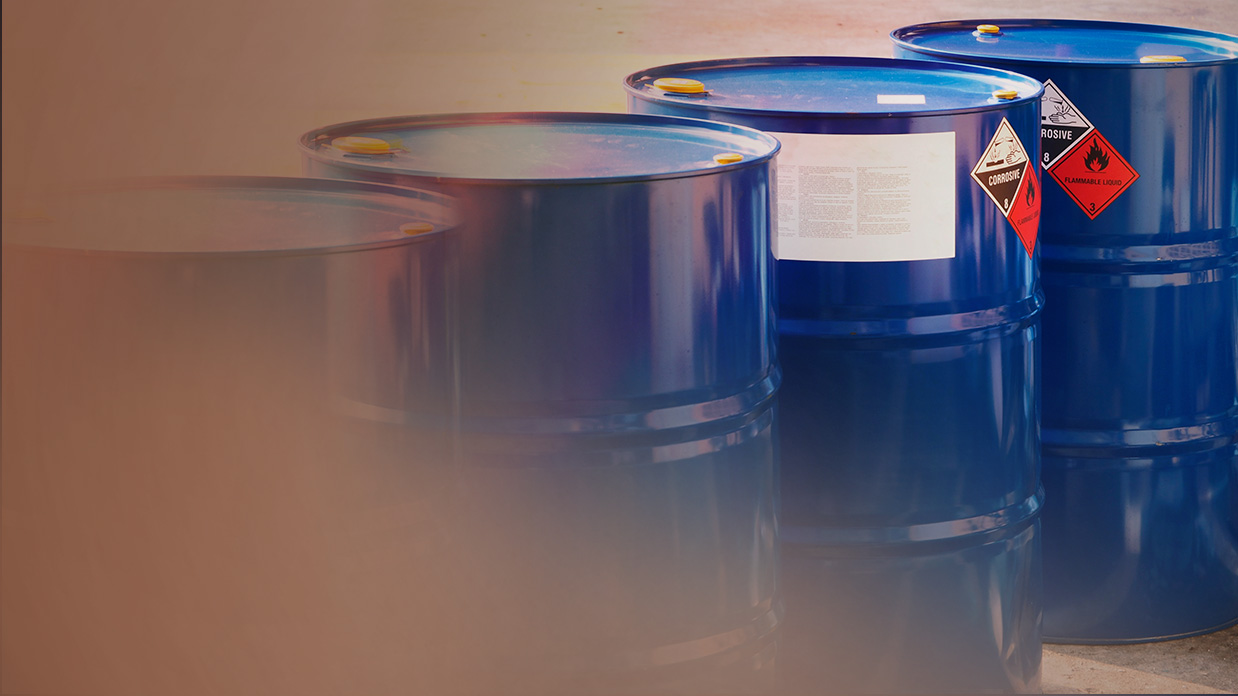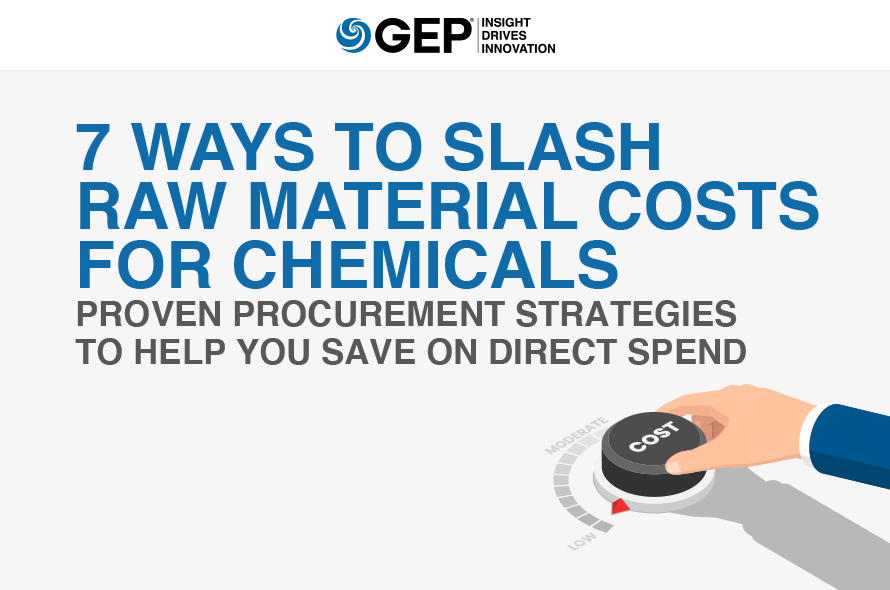For critical raw materials, supply assurance takes priority over costs. There’s no debate here.
But availability doesn’t always have to come at a premium.
And there are better ways to reduce costs than squeezing your strategic suppliers.
In a new bulletin, 7 Ways to Slash Raw Material Costs for Chemicals, GEP’s experts share smart procurement strategies to tame the cost of direct materials. These are simple, yet effective steps you can take to secure supplies at best value under the current economic conditions.
What’s Inside:
- How to ensure supply without paying a huge premium
- Working with your strategic suppliers to unlock savings
- Smart supply planning and purchasing techniques
Read today to learn innovative techniques that can help you contain raw material costs without breaking your strategic suppliers.
Supply assurance is always a high priority for chemical companies, more so when there’s economic uncertainty.During a slowdown, product availability takes precedence over cost as many suppliers are cash-strapped and the risk of supply disruption is high.
However, better availability does not have to come at a premium. The key to containing the cost of raw materials lies in understanding your total costs and all potential sources of value leakage. In this bulletin, GEP’s experts share key strategies that can help your organization stay ahead of the market in a cash-tight environment.
Step Up Supply Planning
Developing and implementing a comprehensive supply chain plan helps source raw materials from the right suppliers at the right time at the right cost and at the right quantity. It reduces the amount of materials spot bought or rush ordered at a higher cost, especially when the market is in short supply. Note that supply risk mitigation and contingency plans should be in place before there’s even a murmur of trouble.
1. Improve supply responsiveness
Raw material suppliers need a reliable forecast to plan with their suppliers and secure the right capacities and stocking levels. This is easily done when demand is steady and predictable. However, demand is hard to estimate when there’s an economic slowdown or when businesses are still recovering. Raw material consumers should start considering a combination of consignment (Vendor Managed Inventory) and on-site storage options for historically high/medium turnover materials, with more than two-day order-to-delivery lead times. These practices have proved to help improve responsiveness to unpredictable upticks in demand, while controlling costs.
2. Build supply redundancies
Both during and just after a recession, customers often face shortages when they rely on suppliers shipping from just one terminal with one delivery option (e.g., trucks). Where possible, consider partnering with suppliers that can ship from multiple terminals using intermodal delivery options within a region.
3. Optimize ordering against contracted buys
The price of raw materials is subject to variations because of multiple supply options and market price changes. An added layer of complexity is contracted buys with minimum volume commitments. GEP has experience in implementing automated linear optimization models that help clients make informed decisions on allocating the right volume to the lowest-priced supplier, without breaching contractual commitments. One of our clients, a resin manufacturer, achieved up to 5% reduction in spend on implementing this model.
Leverage Trade Flow
Because of the diverse nature of end products being served, the buyers of commodity chemicals vary by industry. For example, bleach is used to retain fibers in pulp manufacturing; it also has use in water treatment. Its demand, however, is driven more by water treatment applications. Additionally, the supply-demand dynamics and cost of commodities vary greatly across regions. Therefore, it is imperative for commodity chemicals customers to understand global concentrations of supply and trade balances across regions so that they can partner with distributors that have access to more competitive commodity markets. A combination of publicly available International Trade Center data and detailed market research can help achieve this goal.
True Up Operating Costs
Raw materials typically require to be processed to a desired grade before they can be used. Operating costs make up 15-25% of the landed cost for any given material. Limited visibility into costs is not advantageous to effective negotiations with suppliers. Use cost models that will provide a price breakdown to capture the drivers of operating costs, such as fixed costs (capital), variable costs (raw materials, by-product credits and utilities) and expenses. This will give buyers price transparency and help retain their purchasing power. Cost models should include varying operating rates and production methods, with a range of outcomes that can be used for negotiation.
Diversify Raw Material Profiles
The pandemic is a lesson in the importance of diversification. The global production of chemicals dropped by 2.4% in February 2020,1 leading to large-scale supply disruption of raw materials. It’s time to take a thorough look at the diversification of raw materials in the long term. Reformulations could potentially allow for substitution of critical raw materials, as well as development of alternative markets. A substitute material with a lower cost base would be of great value in a recessionary climate. For example, tapioca starch is a good substitute for potato starch, providing similar fiber retention properties for the paper manufacturing process but at a significantly lower cost.
Tap Into By-Product Synergy
By-product synergy, the productive utilization of by-products generated in a manufacturing or industrial process, can open up additional revenue streams. These by-products, otherwise considered as waste, can also be used commercially, eliminating the need to source them from a manufacturer or distributor. For example, where economically feasible, lower grades of inorganic sodium salts can be recovered as a by-product of the reverse osmosis process used by sea water desalination plants. Such a strategy usually requires a one-time investment in expertise and technology and a discussion with the supplier (of the source of the by-product).
Eliminate Fuel Surcharge
Fuel surcharge accounts for nearly 40% of transportation spend.2 With the crude oil price crash and reduced fuel surcharges, companies should leverage a market fuel surcharge program with carriers. Firms should focus on their tactical logistics management capabilities and integrate logistics procurement, central logistics functions and businesses to systematically study market dynamics so as to improve delivery reliability and reduce logistics cost.
Hedge to Manage Cost and Supply Risk
Utilizing derivative products like futures can be an interesting but daunting proposition for chemical organizations. While the risk of locking in a higher price than the market rate is real, choosing the right chemicals for such an approach is a critical factor for success. For example, commodities with price fluctuations less than 25% annually and limited production capacity could be reasonable candidates for hedging. For this strategy to be successful, the inventory holding cost of stocking the pre-bought commodity should be outweighed by the lower purchase price over the period being hedged.
There is more to raw materials cost management than procurement beating down suppliers on purchase price. Not having these strategies in place during a downturn can significantly impact a company’s P&L, as well as its reputation as a reliable supplier in the marketplace. The effective implementation of these strategies requires a collaborative effort from a cross-functional team involving procurement, supply chain, operations, engineering and R&D. An experienced procurement consultant can help organizations adopt those strategies that are suitable and make such collaborations successful.
1 Anindya Barman, “Global Chemicals February Output Drops on Coronavirus Crisis,” Zacks Investment Research, 27 March 2020. Retrieved 3 September 2020 from www.zacks.com/stock/news/838364/global-chemicals-february-output-drops-o...
2 “Fuel Surcharge: A Shipper’s Perspective,” GEP, 18 March 2016. Retrieved 3 September 2020 from /white-papers/fuel-surcharge-shippers-perspective
TURN IDEAS INTO ACTION. TALK TO GEP
GEP helps enterprise procurement and supply chain teams at hundreds of Fortune 500 and Global 2000 companies rapidly achieve more efficient, more effective operations, with greater reach, improved performance, and increased impact. To learn more about how we can help you, contact us today.
Samir Patel
Vice President, Consulting GEP
Samir leads GEP’s chemicals vertical. He has over 17 years of industry and consulting experience in implementing cost reduction programs for Fortune 500 clients. He has delivered significant value to clients through strategic sourcing, category strategies and best practices, M&A synergy savings, and procurement transformation, in addition to leading procurement execution and strategy for integration and divestitures.

